What’s the Role of Spirulina in a Koi Fish Diet? Complete Nutritional Guide
This post may contain affiliate links.
Spirulina has revolutionized koi fish nutrition, transforming ordinary pond fish into vibrant, healthy specimens with enhanced color brilliance and robust immune systems. This blue-green algae superfood plays multiple crucial roles in optimizing koi fish health, from boosting natural pigmentation to supporting digestive wellness and disease resistance. Understanding how to properly incorporate spirulina into your koi’s diet can dramatically improve their overall quality of life while creating stunning visual displays in your pond.
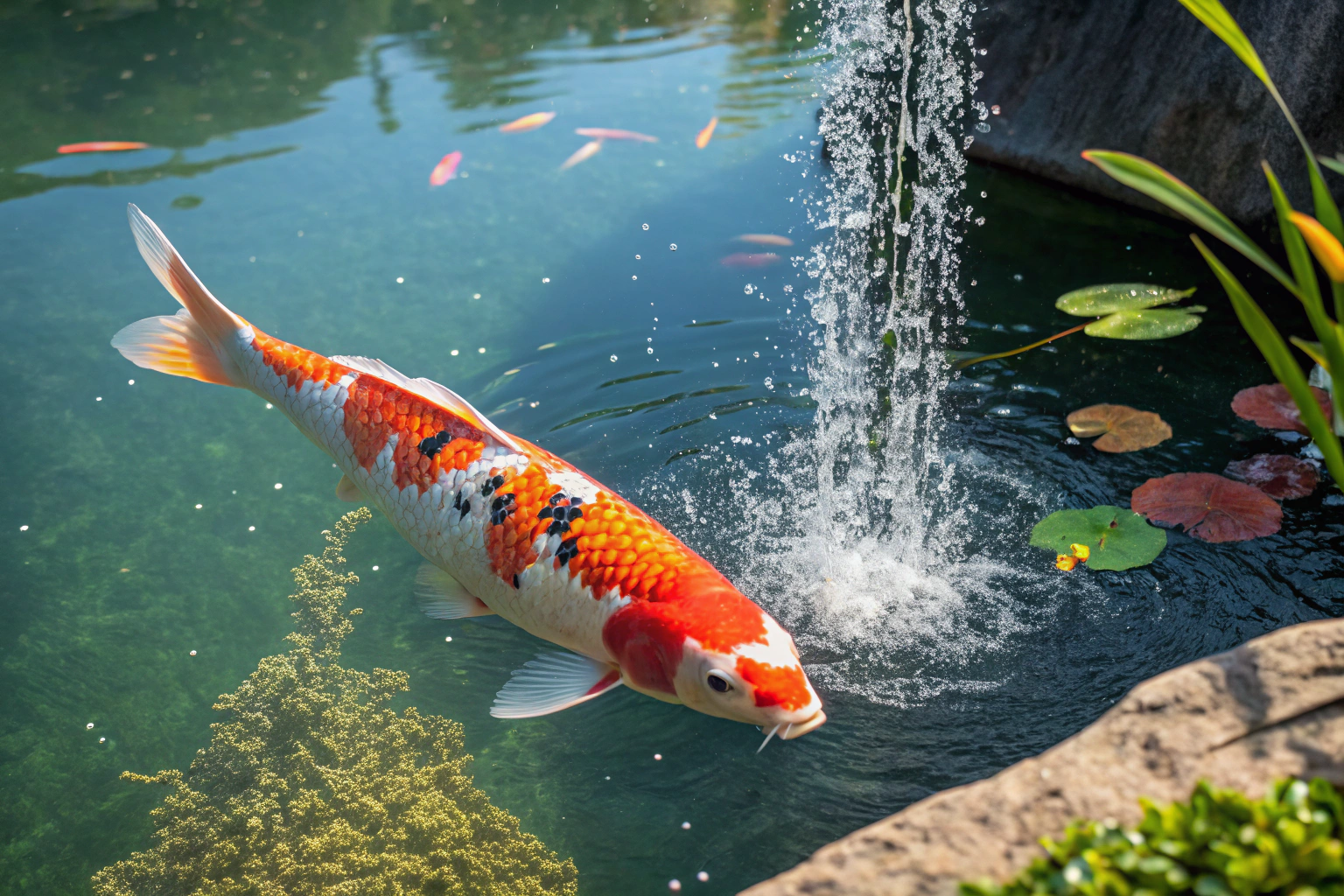
Understanding Spirulina: The Ultimate Koi Superfood
Spirulina (Arthrospira platensis) is a microscopic cyanobacterium that has been recognized as one of nature’s most nutritionally complete foods. For koi fish, spirulina serves as a powerhouse supplement that addresses multiple dietary needs simultaneously. This ancient organism contains an extraordinary concentration of proteins, vitamins, minerals, and antioxidants that perfectly complement the nutritional requirements of ornamental carp.
The unique cellular structure of spirulina makes its nutrients highly bioavailable to koi fish digestive systems. Unlike many synthetic supplements, spirulina’s nutrients are naturally chelated and easily absorbed, ensuring maximum nutritional benefit from every feeding. This superior bioavailability means koi fish can efficiently utilize spirulina’s nutrients for growth, color development, and immune system support.
Research published in the Journal of Aquaculture Nutrition demonstrates that spirulina supplementation in fish diets significantly improves growth rates, feed conversion efficiency, and overall fish health compared to traditional feeding regimens alone.
The Nutritional Profile of Spirulina for Koi Fish
Spirulina’s impressive nutritional profile makes it an ideal supplement for koi fish across all life stages. This microscopic algae contains approximately 60-70% complete protein, including all essential amino acids required for optimal koi growth and development. The high protein content supports muscle development, tissue repair, and overall structural growth in both young and mature koi fish.
The vitamin content of spirulina is particularly beneficial for koi fish health. High concentrations of beta-carotene, vitamin B12, vitamin E, and vitamin K support various physiological functions from immune response to blood clotting. Beta-carotene, in particular, plays a crucial role in enhancing the natural orange and red pigmentation that makes koi fish so visually striking.
Mineral content in spirulina includes essential trace elements like iron, magnesium, potassium, and zinc that support enzymatic functions, bone development, and metabolic processes. These minerals are often deficient in commercial koi foods, making spirulina supplementation particularly valuable for maintaining optimal fish health.
According to nutritional analysis from the Food and Agriculture Organization, spirulina contains more concentrated nutrition per gram than most other natural food sources, making it an exceptionally efficient dietary supplement for ornamental fish.
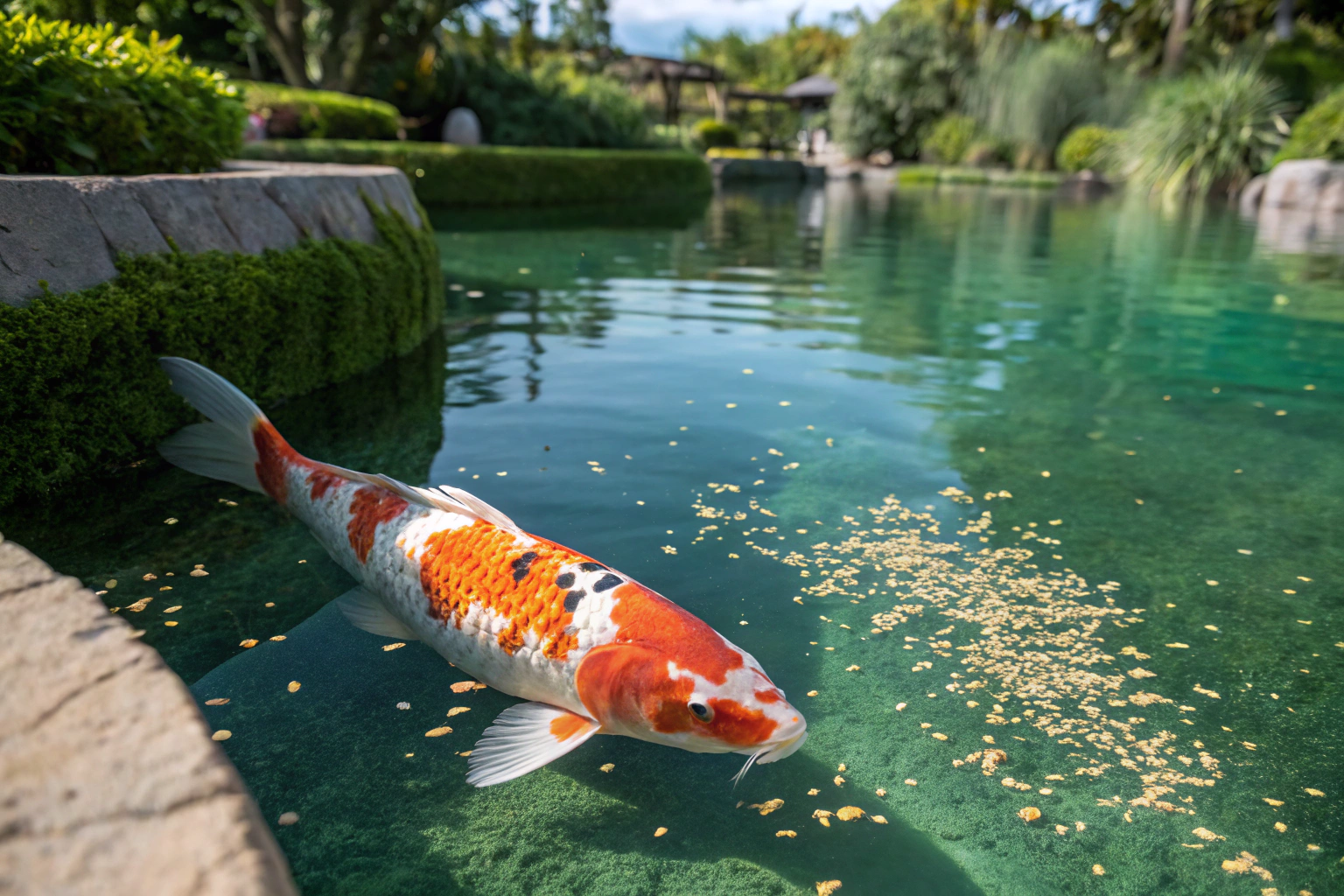
Color Enhancement: Spirulina’s Most Visible Benefit
The most dramatic and immediately noticeable effect of spirulina supplementation in koi diets is enhanced color development and intensity. Spirulina contains natural carotenoid pigments, particularly beta-carotene and phycocyanin, that are directly responsible for intensifying red, orange, and yellow colorations in koi fish scales.
These natural pigments work by being deposited in the koi’s skin and scale cells, creating deeper, more vibrant colors that are highly prized by koi enthusiasts. Unlike artificial color enhancers, spirulina provides sustainable, long-lasting color improvement that develops gradually and naturally over several weeks of consistent feeding.
The color enhancement process requires consistent spirulina supplementation over 6-8 weeks to achieve optimal results. During this period, koi fish gradually build up carotenoid deposits in their pigment cells, resulting in progressively more intense and lustrous coloration. This natural process creates more stable, permanent color improvements compared to artificial alternatives.
Professional koi breeders and show competitors rely heavily on spirulina supplementation to achieve the intense, competition-quality colors that distinguish prize-winning specimens. The American Koi Society recognizes the importance of proper nutrition, including spirulina supplementation, in developing show-quality koi fish.
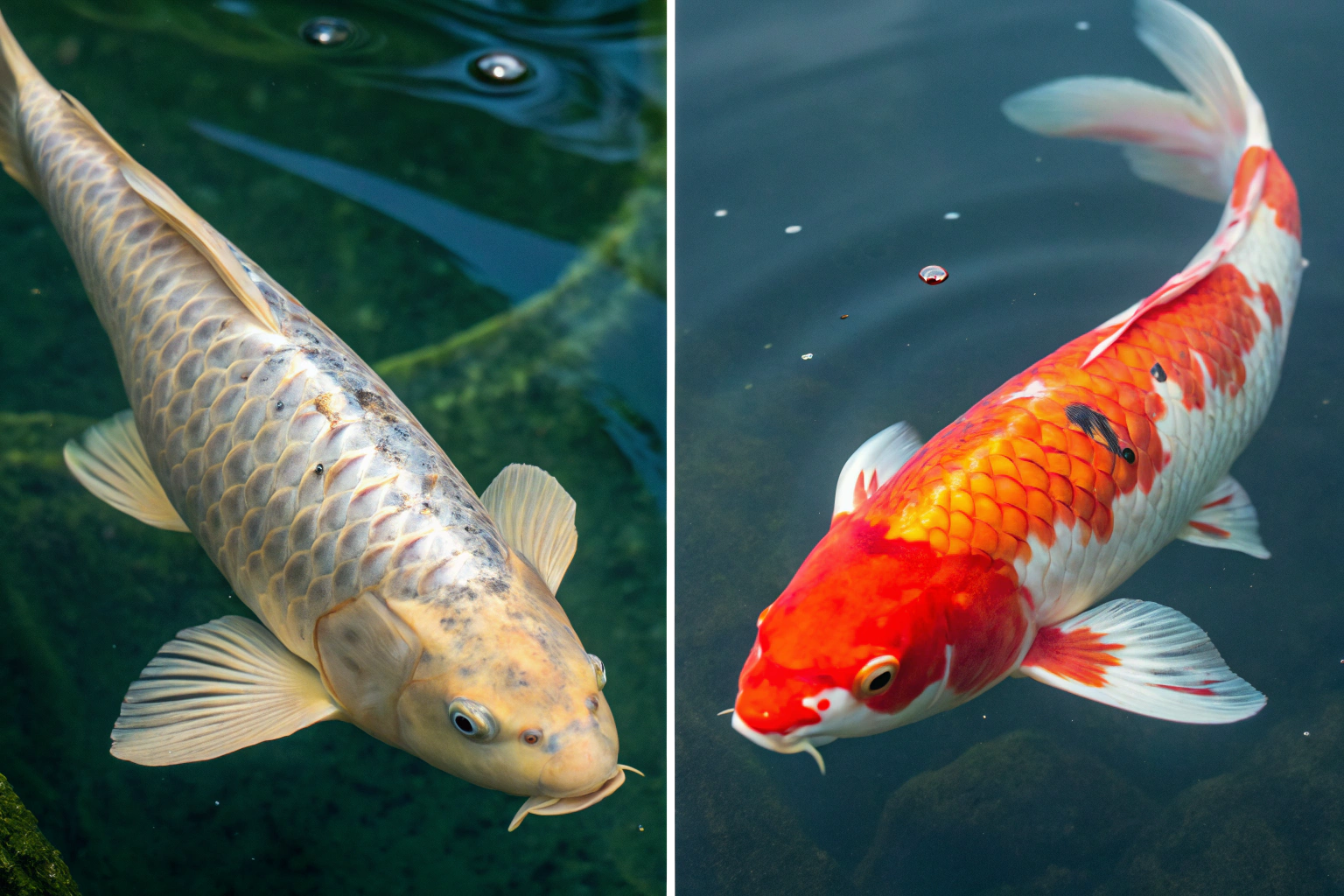
Immune System Support and Disease Prevention
Spirulina’s role extends far beyond color enhancement, providing significant immune system support that helps koi fish resist common diseases and parasites. The high concentration of antioxidants, including phycocyanin, chlorophyll, and beta-carotene, helps neutralize harmful free radicals that can compromise fish immune function.
The immunostimulant properties of spirulina have been extensively studied in aquaculture research. Regular spirulina supplementation increases white blood cell activity, enhances antibody production, and improves overall disease resistance in fish populations. This natural immune support is particularly valuable in pond environments where koi fish face various environmental stressors and potential pathogens.
Spirulina also contains natural anti-inflammatory compounds that help reduce stress responses and support recovery from minor injuries or infections. This anti-inflammatory action complements the immune-boosting effects, creating a comprehensive health support system for pond-raised koi fish.
Studies published in the Fish & Shellfish Immunology Journal demonstrate that fish fed spirulina-supplemented diets show significantly improved survival rates when exposed to bacterial and viral challenges compared to control groups.
Digestive Health and Growth Optimization
The digestive benefits of spirulina supplementation contribute significantly to overall koi fish health and growth performance. Spirulina’s easily digestible protein structure reduces strain on the koi’s digestive system while providing maximum nutritional absorption. This improved digestibility leads to better feed conversion ratios and reduced waste production in pond systems.
Spirulina contains natural enzymes and beneficial compounds that support healthy gut bacteria populations in koi fish. This prebiotic effect promotes optimal digestive function, improves nutrient absorption, and helps maintain healthy intestinal environments that resist harmful bacterial overgrowth.
The growth-promoting effects of spirulina are particularly notable in young koi fish during their rapid development phases. Enhanced protein utilization, combined with improved digestive efficiency, results in faster growth rates and better overall development compared to standard feeding programs alone.
Long-term spirulina supplementation also supports reproductive health in breeding koi, improving egg quality, fertilization rates, and fry survival. These reproductive benefits make spirulina particularly valuable for serious koi breeders focused on maintaining healthy breeding populations.
Proper Spirulina Dosage and Feeding Guidelines
Determining the appropriate spirulina dosage for koi fish requires consideration of fish size, age, season, and specific health goals. Generally, spirulina should comprise 2-5% of the total daily food intake for adult koi fish, with higher percentages appropriate for young, growing fish or during color development periods.
For adult koi fish, a typical feeding schedule includes spirulina-enhanced food 3-4 times per week during active feeding seasons. During peak growth periods in spring and summer, daily spirulina supplementation may be beneficial, while winter feeding should be reduced or eliminated as koi metabolism slows significantly.
The timing of spirulina feeding can impact its effectiveness. Many koi experts recommend feeding spirulina-enhanced foods during morning hours when fish are most active and digestive systems are functioning optimally. This timing maximizes nutrient absorption and utilization efficiency.
Quality spirulina products specifically formulated for koi fish often include feeding guidelines based on fish size and pond temperature. Following manufacturer recommendations while monitoring fish response ensures optimal results without overfeeding or waste accumulation in pond systems.
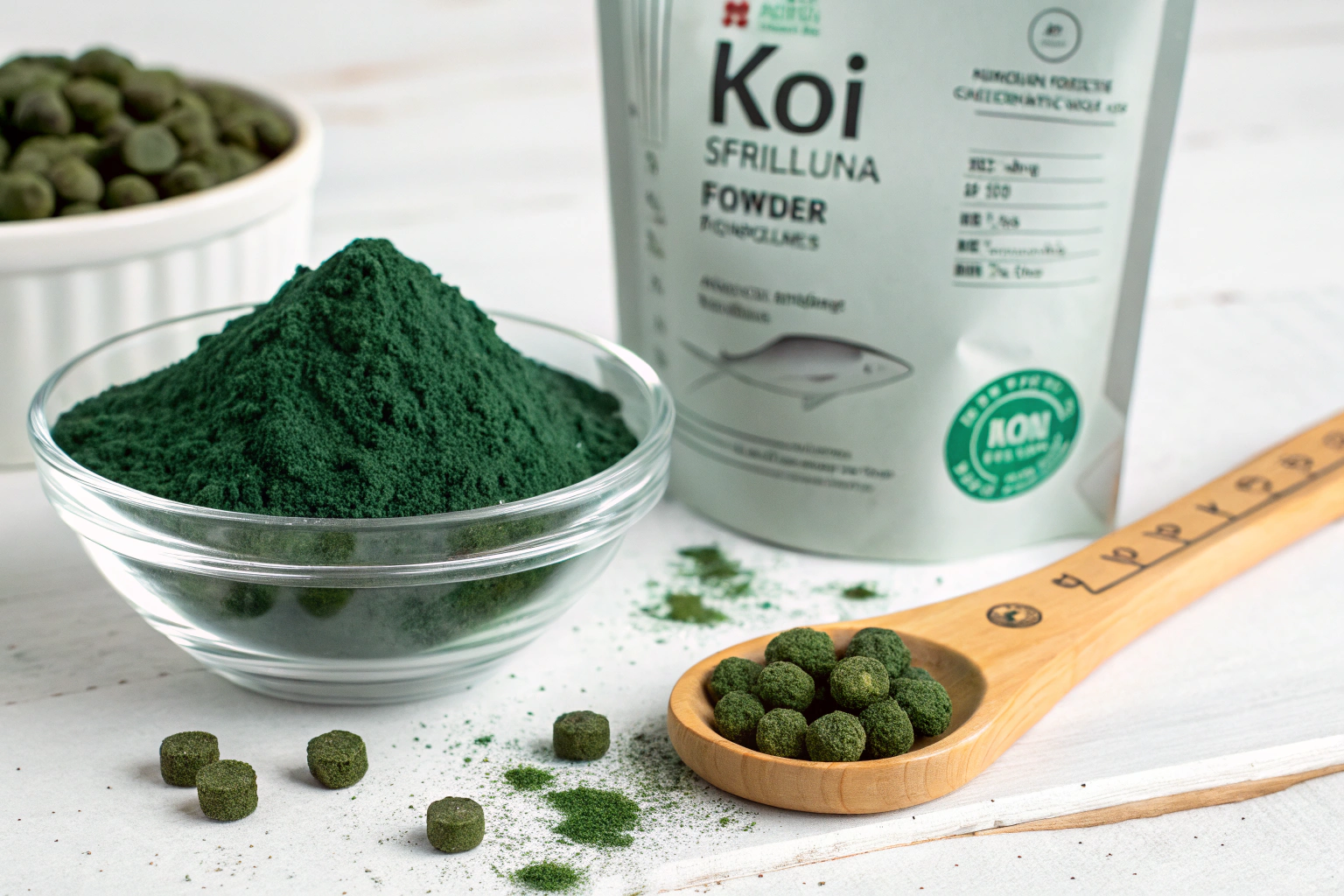
Choosing Quality Spirulina Products for Koi Fish
The quality of spirulina products varies significantly between manufacturers, making careful selection crucial for achieving desired results. High-quality spirulina for koi fish should be specifically processed and formulated for aquatic species, ensuring optimal digestibility and nutrient preservation.
Look for spirulina products that specify the source and cultivation methods used in production. Organically grown spirulina from controlled environments typically offers superior nutritional content and reduced contamination risks compared to wild-harvested or poorly controlled sources.
Processing methods significantly impact spirulina’s nutritional value and stability. Freeze-dried or low-temperature processed spirulina retains more heat-sensitive vitamins and enzymes compared to high-heat processed alternatives. Additionally, proper packaging that protects against light and moisture degradation is essential for maintaining product quality.
Reputable aquaculture suppliers often provide detailed nutritional analysis and feeding recommendations specific to koi fish requirements. The Global Aquaculture Alliance provides guidelines for evaluating aquaculture feed supplements and their quality standards.
Seasonal Considerations for Spirulina Supplementation
Spirulina supplementation strategies should adapt to seasonal changes in koi fish metabolism and nutritional needs. During spring warming periods, increased spirulina feeding supports recovery from winter dormancy and prepares fish for active growing seasons ahead.
Summer months represent peak feeding periods when koi fish can most effectively utilize spirulina’s growth-promoting and color-enhancing properties. Warm water temperatures increase metabolic rates, allowing for optimal nutrient absorption and utilization from spirulina supplementation.
Fall feeding programs should gradually reduce spirulina supplementation as water temperatures decline and koi fish begin preparing for winter dormancy. However, continued moderate supplementation during early fall can help strengthen immune systems before the stress of winter months.
Winter spirulina feeding should be minimal or eliminated entirely when water temperatures drop below 50°F (10°C). At these temperatures, koi fish digestive systems slow dramatically, and undigested food can create water quality problems in closed pond systems.
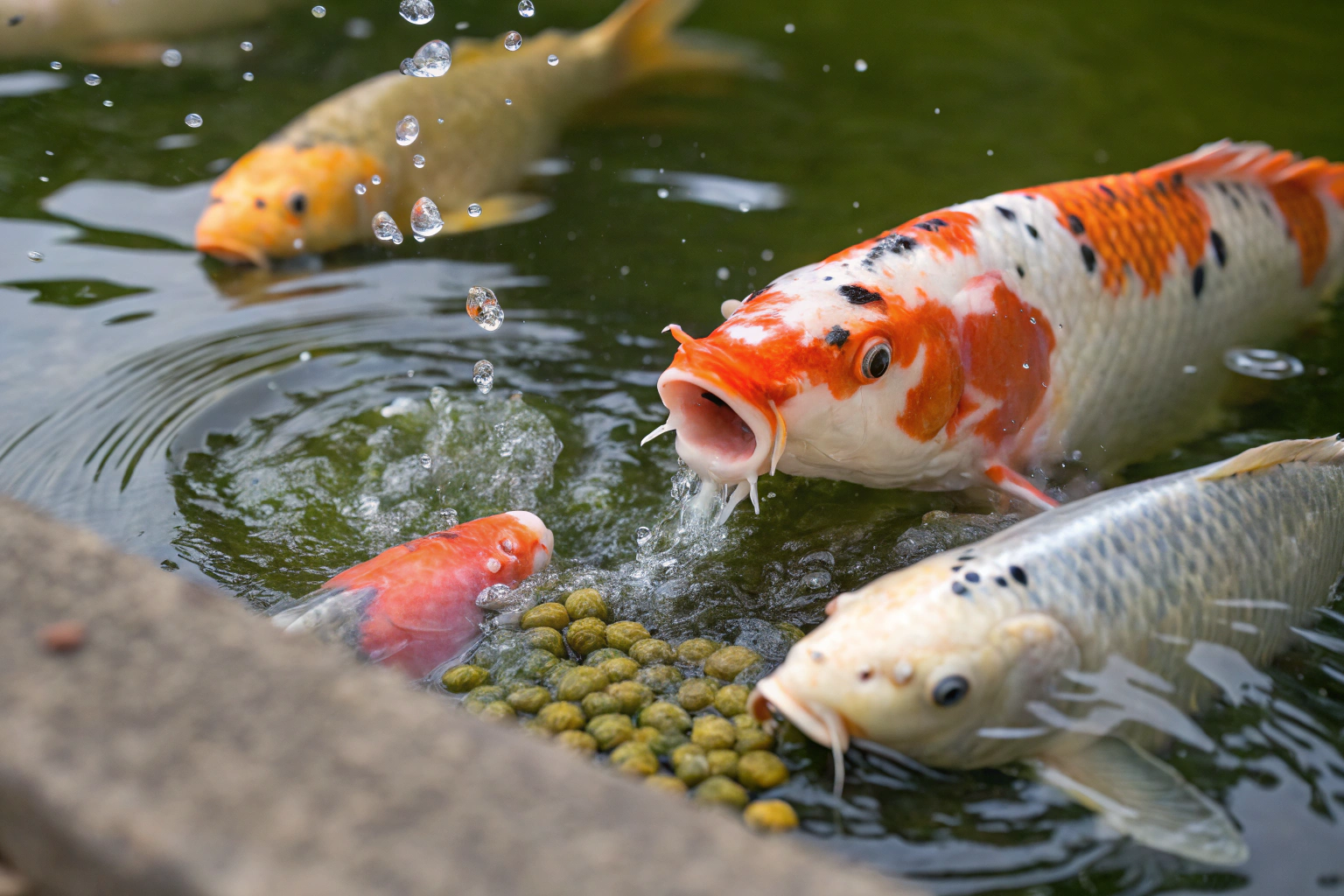
Integration with Complete Koi Nutrition Programs
While spirulina provides exceptional nutritional benefits, it should complement rather than replace a complete, balanced koi diet. High-quality base foods should provide the majority of daily nutritional requirements, with spirulina serving as a specialized supplement for specific health and aesthetic goals.
Balancing spirulina supplementation with other nutritional components ensures koi fish receive comprehensive nutrition without creating dietary imbalances. Excessive spirulina feeding can potentially interfere with the absorption of other nutrients, emphasizing the importance of proper dosage and timing.
Professional koi nutritionists recommend rotating different supplement types throughout the feeding season to provide varied nutritional support. This approach might include spirulina for color enhancement, probiotics for digestive health, and vitamin supplements for immune support in a coordinated feeding program.
The World Aquaculture Society provides extensive research on integrated nutrition approaches for ornamental fish, emphasizing the importance of balanced supplementation programs for optimal fish health and performance.
Common Mistakes in Spirulina Feeding
Many koi owners make critical errors when incorporating spirulina into their fish’s diet, potentially reducing effectiveness or causing unintended problems. Overfeeding spirulina is one of the most common mistakes, leading to water quality issues and potential nutritional imbalances that can harm rather than help koi fish health.
Another frequent error involves inconsistent supplementation schedules that fail to provide the sustained nutritional support necessary for color development and health benefits. Sporadic spirulina feeding provides minimal benefits compared to consistent, properly timed supplementation programs.
Using poor-quality spirulina products or incorrect storage methods can significantly reduce nutritional value and effectiveness. Spirulina exposed to heat, light, or moisture degrades rapidly, losing much of its beneficial nutritional content and potentially developing harmful compounds.
Failing to adjust spirulina supplementation based on seasonal changes, fish age, or specific health conditions represents another common oversight that limits the potential benefits of this powerful supplement.
Monitoring Results and Adjusting Feeding Programs
Successful spirulina supplementation requires careful monitoring of koi fish response and adjustment of feeding programs based on observed results. Color development typically becomes noticeable within 4-6 weeks of consistent supplementation, with continued improvement over several months of proper feeding.
Health improvements from spirulina supplementation may be more subtle but equally important to monitor. Increased activity levels, improved appetite, better growth rates, and reduced disease incidents all indicate successful spirulina integration into the koi’s diet.
Water quality monitoring becomes particularly important when introducing spirulina supplementation, as overfeeding can impact pond chemistry and potentially harm fish health. Regular testing of ammonia, nitrite, and nitrate levels helps ensure feeding programs don’t create water quality problems.
Photographic documentation of color development provides valuable feedback for adjusting spirulina supplementation schedules and dosages. Many successful koi keepers maintain feeding logs and photo records to track long-term progress and optimize their nutritional programs.
Economic Considerations and Cost-Effectiveness
While high-quality spirulina supplements represent a significant investment in koi fish care, the long-term benefits often justify the expense through improved fish health, enhanced colors, and reduced disease treatment costs. Calculating the cost per feeding and comparing it to potential veterinary expenses provides perspective on spirulina’s economic value.
Bulk purchasing of spirulina products can reduce per-unit costs while ensuring consistent availability throughout feeding seasons. However, proper storage is crucial to prevent degradation of bulk quantities, potentially negating economic advantages if products lose nutritional value.
The enhanced aesthetic value of properly colored koi fish can significantly increase their market value for hobbyists interested in breeding or selling their fish. Competition-quality colors achieved through proper spirulina supplementation can dramatically increase individual fish values.
Long-term health benefits from spirulina supplementation may reduce the need for expensive disease treatments, medications, and fish replacements, providing additional economic justification for consistent supplementation programs.
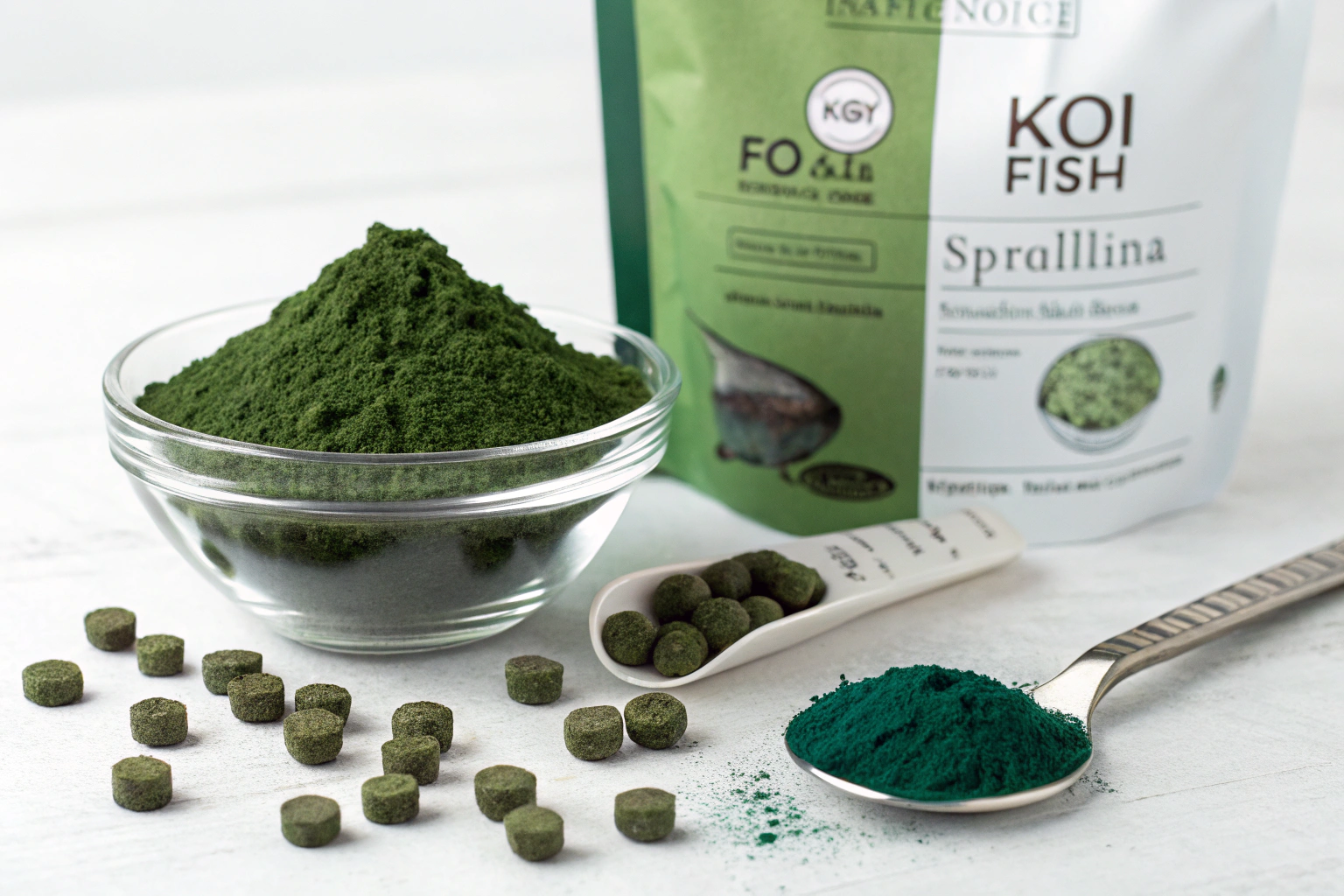
Future Developments in Spirulina Research
Ongoing research into spirulina applications in aquaculture continues to reveal new benefits and applications for koi fish nutrition. Advanced cultivation techniques are producing spirulina strains with enhanced nutritional profiles specifically optimized for ornamental fish requirements.
Emerging processing technologies are improving spirulina bioavailability and stability, potentially increasing the effectiveness of future products while reducing required dosages. These technological advances may make spirulina supplementation more cost-effective and convenient for koi enthusiasts.
Research into combination supplements that pair spirulina with other beneficial compounds shows promise for creating more comprehensive nutritional solutions. These integrated approaches may provide enhanced benefits while simplifying feeding programs for koi keepers.
The growing understanding of fish nutrition and immune function continues to validate spirulina’s role as a crucial component in optimal koi fish care, supporting its continued use and development in aquaculture applications.
Conclusion
Spirulina plays an indispensable role in modern koi fish nutrition, providing unparalleled benefits for color enhancement, immune support, digestive health, and overall fish welfare. When properly incorporated into comprehensive feeding programs, spirulina transforms ordinary koi into vibrant, healthy specimens that represent the pinnacle of ornamental fish keeping.
The key to successful spirulina supplementation lies in understanding proper dosage, timing, and integration with complete nutritional programs. Quality product selection, consistent application, and careful monitoring ensure maximum benefits while avoiding common pitfalls that can reduce effectiveness.
As research continues to validate and expand our understanding of spirulina’s benefits, this remarkable supplement will undoubtedly remain a cornerstone of advanced koi fish care. For serious koi enthusiasts committed to maintaining healthy, beautiful fish, spirulina supplementation represents an essential investment in their pond’s success.
The transformation achieved through proper spirulina supplementation extends beyond individual fish health to encompass the entire pond ecosystem, creating vibrant, thriving aquatic environments that provide years of enjoyment and satisfaction for dedicated koi keepers.
